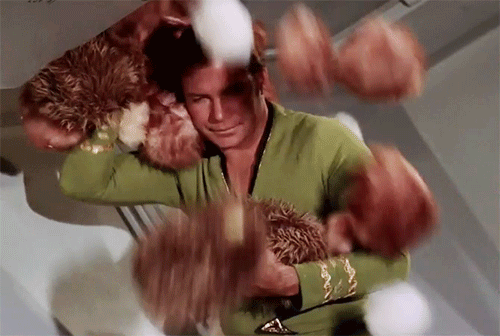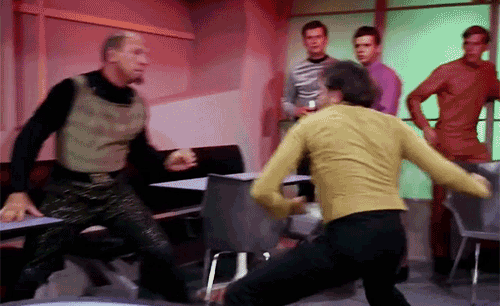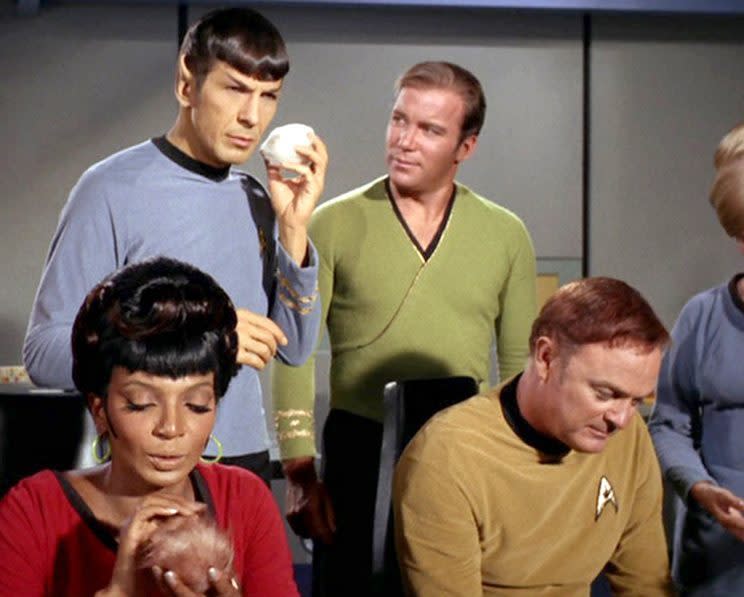‘Star Trek’ Flashback: Writer David Gerrold Talks ‘Tribbles’

Fifty years young this year, the original Star Trek series boasts a plethora of classic episodes. But when it came time for this mild-mannered Trekkie to introduce his two young Starfleet cadets to Gene Roddenberry’s final frontier, there was only one gateway voyage I considered: “The Trouble With Tribbles.” First aired on Dec. 29, 1967 — midway through the show’s second season — “Tribbles” may not be the most dramatic hour of Trek, but that’s a big part of its charm.
Depicting the infestation of the Enterprise by a gaggle of rapidly replicating balls of fluff called Tribbles, the episode is light-hearted enough to engage the attention of new viewers, while still offering vintage Trek elements like Klingons, Shatner-isms (“This is my chicken sandwich and coffee!”) and Spock and Bones snarkfests. In advance of the three-day Trek-thon, Star Trek: Mission New York, I spoke with the man behind “Tribbles,” writer David Gerrold, about the origin of the episode (which is newly available as part of a mammoth 50th Anniversary Blu-ray set that debuts on Tuesday), its lasting legacy, and whether we can expect to see more of those fur balls in Bryan Fuller’s upcoming Star Trek: Discovery series.
Yahoo TV: First off, congratulations on 50 years of Star Trek! Which also means 50 years of being asked about “The Trouble With Tribbles.”
David Gerrold: Yes, I have written other stuff for Star Trek as well as other shows, but I’m always pleased that people remember “Tribbles.” The idea grew out of looking at the first few episodes of Star Trek, including “The Man Thing.” I thought, “We’re not going to recognize the danger with every alien we meet. The ones who are going to be the most dangerous are the ones we’re not going to realize are dangerous until it’s too late.” So I came up with the idea of these cute little fuzzy creatures. I was always fascinated by ecology, and I was inspired by the case of rabbits in Australia, this whole idea that they became predators because there weren’t any predators already there. I had the great privilege of working with producer Gene L. Coon, who told me what the studio still needed, while giving me the room to be inventive. I can’t think of a better training ground for a young writer.

Watching “Tribbles” again recently, I remembered that there’s so much more to the episode than just the Tribbles. Chekov’s bar fight with the Klingons, for example.
Walter [Koenig] really enjoyed doing that scene. One of the things I wanted to accomplish with the episode was giving the other Enterprise characters as much to do as possible. When I studied screenwriting at USC’s film school, there was a teacher who hammered my class religiously on story structure. So when I was working on “Tribbles,” I was very conscious that this scene set up that scene. I think the real strength of the script is not that the scenes are funny — it’s that they’re in the right order! When the episode went into production, the script remained essentially unchanged the story structure was correct. There were two scenes that Coon added: the teaser at the beginning with Chekov and the scene with Spock and McCoy in the lab when Spock talks about the ermine violin.
How did Gene Roddenberry feel about the episode?
Gene was on vacation all that summer, and when he came back, he was a little bit disturbed that the show had taken so many comedic turns. I believe that was one of the reasons why Gene Coon left the show; Roddenberry wanted more gravitas, and Coon felt we needed to lighten up so our characters were more human.
Related: Ranking 50 Years of ‘Star Trek’ Series Premieres
The film series later followed a similar trajectory as well, from the seriousness of The Motion Picture to the comedy of The Voyage Home.
Harve Bennett took over with The Wrath of Khan, and he understood that these actors were capable of comedy and that they loved doing it. We were lucky to have such an extremely talented cast who knew their characters very well, and could be funny without breaking character.
Were you on set during the shooting of “Tribbles”?
Yes, I was on the set every day, but I was very young and inexperienced so I didn’t talk to anybody. I just stood and watched. I was even embarrassed to ask to have my picture taken with the cast! They were all in character so intimidating; I wouldn’t even talk to the guys dressed up as Klingons. They were so scary! [Laughs] Working on Trek spoiled me. When you’re working with those actors you get spoiled, and then you go to other shows and realize you can’t write dialogue that is nuanced or clever because [the cast] doesn’t know how to deliver the lines with the same sense of timing.
How did the experience of writing for Star Trek at that time differ from other shows that you worked on later?
We didn’t have a writers’ room, we had a story editor, line producer, showrunner, and executive producer. And if Roddenberry was present, he’d be part of the process. I don’t think I’ve ever been part of a writers’ room; I’ve sat in on production meetings where we’re throwing ideas at each other, and that’s exciting when you’ve assembled the right ensemble of creative people. The industry has changed; we no longer have freelance writers, we have writing staffs. There are strengths to that, but there’s also a weakness: If you have a writers’ room, you’re not going to get a “Trouble With Tribbles.” You’re not going to get that guy who comes in with the oddball idea that illuminates everything else you’re doing. “Tribbles” was a fluke, but it worked to highlight a whole other aspect of what was possible on Star Trek. When you don’t get ideas coming in from outside, there’s a bit of a tendency to get insular unless you have an ambitious writing staff.
These days, you’d have instant feedback after your episode airs thanks to social media outlets like Twitter. When did you get a sense of the fan reaction to “Tribbles”?
I didn’t know how well the episode had been received until a year later when I went to a meeting of the Los Angeles Science Fantasy Society, and they told me five episodes of Star Trek had been nominated for a Hugo Award, including “Tribbles.” That was a very big clue to me that Star Trek’s comedy episodes were as appreciated as the serious ones.

The Tribbles later returned on Star Trek: The Animated Series and Deep Space Nine. Did you enjoy both of those appearances?
Dorothy Fontana became the producer of the animated series and called me to do a sequel to the “Tribbles.” I had a lot of fun writing it. She said, “You have to write this just as you’d write a primetime episode, because that’s what the audience expects.” Filmation [the famous animation studio that produced the cartoon series] was almost walking distance from my house, so I spent a lot of time over there seeing what the animators were doing. Today, you see how limited the animation was, but at the time, I was thrilled it was so accurate to the original series. Those episodes could have been done live action except the special effects budget would have broken the back of the studio! For the Deep Space Nine episode [“Trials and Tribble-ations”], I thought they did a brilliant job recreating the look and feel of the original series. They went back to the original lenses, makeup, lighting, and film stock. I was an extra on that episode, and it was like traveling back in time 30 years.
Do you know if there are any plans to bring back the Tribbles for Star Trek: Discovery?
I was sitting by my phone, but it never rang. [Laughs] I have no idea what Bryan Fuller has planned, but I know he’s an incredibly talented producer. And he’s got Nicholas Meyer, who is also one of my favorite writers. I think it’s going to be a very, very good series.
Star Trek is available for streaming on Netflix and Amazon Prime.

